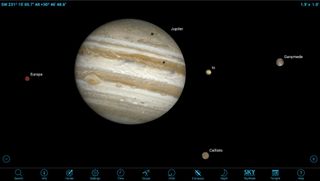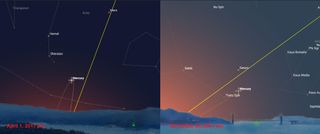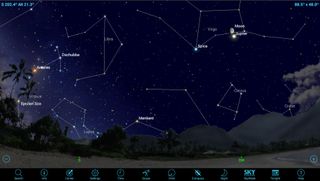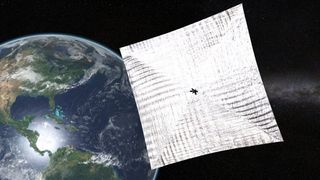Previewing 2017's Biggest Skywatching Events Using Mobile Astronomy Apps — Part 2

For people in or near the U.S., the biggest astronomical event for 2017 will be the Great American Total Solar Eclipse on Aug. 21, but there are many more astro-events to watch out for this year. Here's what to add to your calendar and the mobile apps to help you understand and spot the events.
In this second part of our 2017 preview, we'll cover how you can use mobile apps to spot elusive Mercury, see the motions of Jupiter's largest moons and the planet's Great Red Spot, and track the Planetary Society's shiny solar sailing spacecraft, called LightSail 2, when it launches later this year. Read Part 1 of the 2017 guide here.
Spot elusive Mercury
2017 brings two excellent opportunities to spot the elusive planet Mercury, even with the naked eye, and you can preview the events and plan your observations using astronomy apps. [Photos of Mercury from NASA's Messenger Spacecraft]
Mercury travels quickly around the sun, completing an orbit every 88 days. As the innermost planet, it never ventures very far from the sun in Earth's sky. But each time Mercury swings to the outer reaches of its orbit east or west of the sun (also known as elongations), skywatchers get an opportunity to see the planet after dusk or before dawn, while the sun is still below the horizon. Although Mercury can be visually bright at times, it still has to stand out against the twilight sky, so some appearances are excellent, while others are hardly worth viewing.
Depending on the season, the plane of the solar system, roughly defined by the ecliptic, makes an angle with the horizon that ranges from nearly vertical to very shallow. You can demonstrate the effect by displaying the ecliptic line in your app; select it under Settings. To see how the angle varies, set the app's time to sunset or sunrise, set the view to due east or due west, and advance the date. Over the course of one year, the angle varies up and down, returning to the same position one year later.
When Mercury appearances coincide with a near-vertical ecliptic, the sun is well below the horizon while Mercury remains in view against a darker sky (an excellent apparition). This is also the best time to view the planet in your telescope, since higher objects shine through less distorting atmosphere. When the appearance happens while the ecliptic is more horizontal, Mercury is deep in the twilight glow (a poor apparition). The planet's orbit is inclined by 7 degrees to the ecliptic, so viewers can still get a pretty good apparition when the planet is sitting well above a shallow ecliptic, or a so-so apparition when Mercury is below a steeper ecliptic.

For the Northern Hemisphere during 2017, the two best apparitions of Mercury occur around April 1 and Sept. 12. The spring apparition is an evening one, with Mercury approaching Earth while growing in disk size, and waning from a nearly full disk to a thin crescent. You can start to look for the planet low in the western evening sky after mid-March between 7:45 p.m. and 8 p.m. local time. By April 1, Mercury is setting 2 hours after the sun, with the best viewing times between 8:45 p.m. and 9 p.m. After April 7, the planet becomes unobservable again. Use your astronomy app to see what direction Mercury is in during the appearance, and find a location with an open horizon in that direction.
Get the Space.com Newsletter
Breaking space news, the latest updates on rocket launches, skywatching events and more!
The other excellent Mercury appearance occurs before dawn on Sept. 12. During this appearance, Mercury brightens steadily and grows in phase, while shrinking in size as it moves away from Earth. You can start to look for the planet around Sept. 5 between 5:40 a.m. and 6:10 a.m. local time. On Sept. 12, Mercury rises 1.75 hours before the sun, with peak visibility between 5:30 a.m. and 6:15 a.m. On that date, Mercury also forms a chain between the bright star Spica and Mars, with Venus somewhat higher. After Sept 12, visibility will continue for about two weeks.
Southern Hemisphere observers get their best Mercury appearances at different times, which you can easily find by centering Mercury in your app and scrolling through the year at dusk and dawn. The SkySafari 5 app for iOS and Android includes quick links to the next elongation, regardless of your location.
See Jupiter's moons dance, and the Great Red Spot
Jupiter reaches peak visibility for 2017 just in time for summer. Even a small telescope will reveal the dance of the four orbiting Galilean moons and the planet's creamy beige and brown equatorial belts. A larger backyard telescope can also show the small, round shadows cast on the giant planet by its moons, and can reveal the Great Red Spot, a cyclonic storm many times larger than the Earth that has been raging for 400 years. But these sights are available only at very specific times, and mobile apps are the perfect way to spot them. [Exploring Jupiter and Its Moons with Mobile Apps]
Jupiter is a target for evening stargazing from February until the end of summer. The best night for observing Jupiter is April 7, when the Earth's motion carries the planet between Jupiter and the sun, bringing Earthlings to their closest point to the giant planet for the year. On that date, referred to as opposition, Jupiter rises as the sun sets and appears brighter and closer than on any other date in 2017. Don't be discouraged if you're clouded out. The weeks surrounding that date are almost as good for viewing Jupiter.
The four large moons that Galileo discovered in 1609 are easy targets to observe, even using strong binoculars. In order of distance from the planet, the moons are named Io, Europa, Callisto, and Ganymede. Io completes an orbit every 1.77 days, while the others take 3.55, 7.16 and 16.69 days, respectively. Because of this, the moons are arranged differently every night, sometimes on either side of Jupiter, all to one side, or even hidden from view as they pass behind or in front of the planet. Your astronomy app shows the moons' arrangement at any given time.

Using a slightly larger backyard telescope, such as a 3-inch (80 millimeters) refractor or a 6-inch (150mm) reflector (or better), observers can also watch the moons cast their black, round shadows on Jupiter as the satellites pass in front of it, known as completing a transit. Viewed from the surface of Jupiter, these would be solar eclipses! Depending on which moon is crossing, the shadows take 2 to 3 hours to cross the planet. (The moons themselves are similar in color to the giant planet, so a larger-diameter telescope, of 8 inches (200mm) or higher, is required to see them during their transits.)
Around the time of opposition, the shadow transits happen more frequently, because the sun is shining directly onto the planet and the moons' shadows are cast on Jupiter, instead of sideways into space. With Io crossing the planet every 1.77 days (or 43 hours), single-shadow transits are fairly common, but simultaneous double- and triple-shadow transits happen, too. And it's worth setting up the telescope for these. The following table lists the best double-shadow transit events for 2017. The durations indicate how long the two shadows are visible.
May 18: Double shadows plus moon for 49 minutes, starts at 11:55 p.m. EST
May 26: Double shadows plus moon for 72 minutes, starts at 1:47 a.m. EST
June 3: Double shadows plus moon for 55 minutes, starts at 10:21 p.m. EST
June 19: Double shadows for 35 minutes, starts at 10:04 p.m. EST
I have omitted shadow events that are visible only in other parts of the world, when Jupiter has set or is in daylight for North America. Using astronomy apps like SkySafari 5, you can select and center Jupiter on any evening, and advance the hour and date to find the moon events that you can observe at your own location. There are other Jovian moon phenomena, too: The satellites eclipse (cast shadows on) one another, occult (cross in front of) one another, and can wink into and out of view as they encounter Jupiter's shadow. There are even times when all four moons disappear from view! [Photos: The Galilean Moons of Jupiter]
With a small backyard telescope, such as a 2.75-inch (70mm) refractor or a 4-inch (100mm) reflector, it is easy to observe the Great Red Spot (GRS) on Jupiter, too. But you need to know when to look. Jupiter rotates once every 10 hours, and the GRS takes about 3 hours to cross the planet, so the spot is visible only at certain times. The apps mentioned below will tell you when the spot is at the center of the planet's disk, so you can begin to look for the feature more than an hour ahead of time and can expect to see it for an hour afterward. Remember that your telescope may flip the spot to the opposite side from where you're expecting it to be. In recent years, the spot's color has faded from a strong red to a paler tone, making the feature less obvious — so look carefully.
SkySafari 5 includes quick links to upcoming Jupiter events, such as the next GRS transit, upcoming moon and moon-shadow transits, and moon eclipses. Another option is to choose an app that specializes on Jupiter. Sky and Telescope has a very good app for iOS called JupiterMoons (developed by the SkySafari app team). It allows you to view the planet's current appearance and move forward and backward in time to see what Jupiter looks like at different dates. A separate page provides a list of upcoming GRS transits in local time, and another offers plenty of Jupiter facts and figures.
The Gas Giants app has an extensive menu of commercial telescopes and eyepieces that you can use to match your own setup. This way, the app can show you exactly what you should see in your telescope, accounting for the way your optics inverts or mirror-images the view.
Don't forget Saturn
2017 is also a great year to look at Saturn, although the planet is a little lower in the sky than we prefer. The ringed planet reaches opposition on Jun 15 and is available for evening viewing from May through October. This year, the rings appear at their widest, because the north pole of the planet is tipped toward Earth. To see the rings vary in width, center Saturn in your app and run the years forward and backward. The rings will actually disappear, from Earth's point of view, in November 2025! [Exploring the Realm of Saturn with Mobile Astronomy Apps]

Beautiful celestial groupings
The moon makes a lovely sight when it sits near another bright planet or star, and things get even prettier when more objects join the party. This year brings several of these naked-eye or binocular conjunctions (the correct astronomical term for the closest approach between celestial bodies is appulse), and they make terrific photo ops. Mark these on your calendar.
An excellent conjunction mentioned in the last column bears repeating. On the evening of Jan. 31, Mars, Venus and the young crescent moon form a tight triangle in the western sky. All three fit within the field of view of binoculars. Be on the lookout for earthshine in the dark portion of the moon. In the west after sunset on March 1, the trio gathers again in a more spread-out arrangement. This time, faint Uranus joins them, sitting just 2 degrees below Mars.
Jupiter sits near the bright star Spica in the constellation Virgo all year, so the moon makes a pretty threesome with them four times during 2017. The nearly full moon will sit about 2 degrees from Jupiter on the evening of May 7, with the pair 9 degrees above Spica. They repeat that arrangement, but sitting even closer together, on June 3. The trio makes a nice triangle again in the southwestern sky on July 1 and July 28.
Before sunrise on May 22, the old crescent moon sits 4 degrees to the lower right of Venus in the eastern sky. The moon returns, 8 degrees to the right of Venus, on June 20, and the bright star Aldebaran joins the two objects on July 20.
The old moon makes another regular visit with Venus before dawn on Aug. 18-19, but the fun really starts in September, when Mercury and Mars join the party. The moon makes its way past Venus, the bright star Regulus, Mars and Mercury from Sept. 17 to 19. The moon joins Venus and Mars again on Oct. 17-18. The eastern predawn sky from Nov. 14 to 17 brings another spectacular sight, when the waning crescent moon shuttles through a chain of bright objects: Mars, Spica, Jupiter and Venus. The year ends with the moon returning to Spica, Mars and Jupiter from Dec. 12 to 15, but by this time, Venus has departed the scene.

The moon visits Saturn several times this summer, too. Use your astronomy app to preview those events. You can also plan your conjunction photos by previewing where the objects will be. It's a great idea to compose photos framed by a nice landscape or cityscape.
Going beyond with LightSail 2
Later in 2017, the Planetary Society expects to launch its second solar sailing spacecraft, called LightSail 2, and it should be visible to skywatchers for the duration of the mission. Lightsails are spacecraft propelled by the push of sunlight falling on large, lightweight areas of brightly reflective Mylar film. By altering the orientation of the sails, the spacecraft can maneuver around. Engineers aim to make these craft an option for traversing interplanetary space. LightSail 2 will have sails totaling 32 square meters (340 square feet). [Incredible Tech: How Interstellar Light-Propelled Sailing Works (Infographic)]
As they do for the International Space Station, apps and websites will tell you when you can see LightSail 2 crossing the night sky. For the previous LightSail 1 test, in 2015, the websites n2yo.com and Heavens-Above.com provided daily predictions of sightings during the craft's week in orbit. (Space.com's satellite tracker is also powered by N2YO.)
SkySafari 5 and the better satellite tracking apps, such as ISS Detector, will likely include LightSail 2 once its orbit is defined. For this mission, the sails are deployed for at least a month. The planned orbital inclination carries the craft only 24 degrees north and south of the equator, so low-latitude observers have the best chance to see this treat.

In future editions of Mobile Astronomy, we'll cover the solar eclipse, discuss the moon occulting planets and stars, tell you how to see a comet, review some new apps, and do a lot more. Until then, keep looking up!
Editor's note: Chris Vaughan is an astronomy public outreach and education specialist, and operator of the historic 1.88-meter David Dunlap Observatory telescope. You can reach him via email, and follow him on Twitter @astrogeoguy, as well as on Facebook and Tumblr.
This article was provided by Simulation Curriculum, the leader in space science curriculum solutions and the makers of the SkySafari app for Android and iOS. Follow SkySafari on Twitter @SkySafariAstro. Follow us @Spacedotcom, Facebook and Google+. Original article on Space.com.
Join our Space Forums to keep talking space on the latest missions, night sky and more! And if you have a news tip, correction or comment, let us know at: community@space.com.
Chris Vaughan, aka @astrogeoguy, is an award-winning astronomer and Earth scientist with Astrogeo.ca, based near Toronto, Canada. He is a member of the Royal Astronomical Society of Canada and hosts their Insider's Guide to the Galaxy webcasts on YouTube. An avid visual astronomer, Chris operates the historic 74˝ telescope at the David Dunlap Observatory. He frequently organizes local star parties and solar astronomy sessions, and regularly delivers presentations about astronomy and Earth and planetary science, to students and the public in his Digital Starlab portable planetarium. His weekly Astronomy Skylights blog at www.AstroGeo.ca is enjoyed by readers worldwide. He is a regular contributor to SkyNews magazine, writes the monthly Night Sky Calendar for Space.com in cooperation with Simulation Curriculum, the creators of Starry Night and SkySafari, and content for several popular astronomy apps. His book "110 Things to See with a Telescope", was released in 2021.


